UBC Farm Seed Catalogue
Buy seed grown and developed at the UBC Farm
Here at the UBC Farm, we are committed to preserving our seeds as certified organic, open-pollinated, regionally adapted, held in the public domain, and GE-free.
One of our core beliefs is that seed sovereignty is an essential part of sustainable bioregional food systems. That is why we are dedicated to our seed trials research with FarmFolkCityFolk, and are founding members of BC’s very own Eco Seed Co-op. If you are looking for ecologically sound seeds for your garden or farm, and want to support research for the public interest, consider growing your farm or garden with our seeds.
Our seeds are available to buy online at the BC Eco Seed Co-op
Did you know? The CSFS at the UBC Farm is a founding member of the BC Eco Seed Co-op: a producers’ co-operative growing and providing 100% BC-grown seed that is ecologically grown and certified organic, open-pollinated, regionally selected, and GE-free.
Frequently Asked Questions
- Where can I buy UBC Farm seeds? We currently have UBC Farm seed packets in our retail partners: the UBC Bookstore and the UBC Botanical Garden shop. You can also purchase them at our markets on Tuesdays, Wednesdays and Saturdays - Market times and info here!
- What should I grow indoors, in low light, or in small spaces? We recommend growing plants that are faster from planting to harvest date, such as radishes, lettuce, arugula, and parsley!
- What should I plant to attract pollinators? Plant things that flower at different times of year to provide food for pollinators! Lupin, phacelia, calendula, anise hyssop, and bachelor buttons are flowers you can plant these into your landscaping that will come back every year if you let some of the plants to seed.
- Which seeds are great for growing sprouts or microgreens? Arugula, radish, kale, sorrel, and pea are all make tasty sprouts and microgreens.
Visit the UBC Farm Seed Hub page to learn about seed saving research.
UBC Farm’s Digital Seed Catalogue, available for spring 2024.
The UBC Farm produces seeds of 20 to 30 different crop varieties each year from 15 to 20 different crops, including an array of vegetable, bean, flower, and herb species. Seed crops are produced as part of integrated cropping systems at the Farm and are harvested and processed using small-scale equipment.
Root Vegetables
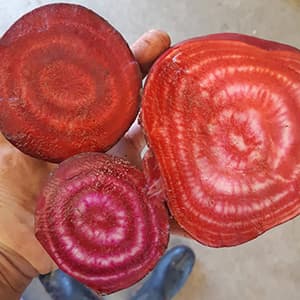
Golden Chioggia
BeetDirect sow anytime from mid-April to early August. Sow 1cm deep, 5 apart with 30cm between rows. For larger beets, thin beet seedlings to 7-15cm apart when seedlings are 5cm tall. Harvest when beets are between golf ball and apple size. Min. germination rate: 75%.
A mixed population bred at UBC Farm from crossing a striped Chioggia beet with a golden beet. Beet flesh ranges from scarlet to coral with light striping. Strong, tasty tops and good size make this a must-try for beet aficionados.
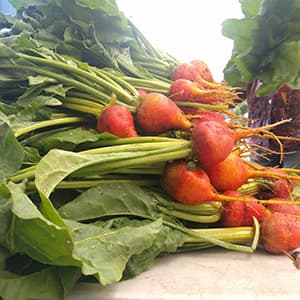
Touchstone Gold
BeetDirect sow anytime from mid-April to early August. Sow 1cm deep, 5 apart with 30cm between rows. For larger beets, thin beet seedlings to 7-15cm apart when seedlings are 5cm tall. Harvest when beets are between golf-ball and apple size. Min. germination rate: 75%.
The classic golden yellow beet. Those who are not fond of the earthy flavour of red beets should try touchstone gold – they are sweeter and milder tasting than their red counterparts.
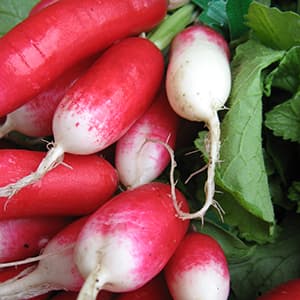
French Breakfast
RadishDirectly sow from March to April with successive crops every 2 weeks. Plant seeds 1 cm deep and with a spacing of 3cm apart. Radish can be harvested once reaching maturity after approximately 27 days. Min. germination rate: 80%.
A rounded cylindrical shape with vibrant scarlet rose at the top that fades into white tips. Breakfast radishes are crisp and delicious with a mildly spicy kick when eaten raw, roasted or baked to soft silky perfection.
Leafy Vegetables
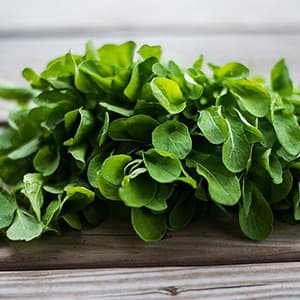
Astro
ArugulaSow seeds directly 5 cm apart in rows 45cm apart between April- August every four weeks. Baby greens can be harvested after 21 days, and larger leaves after 28 days. Plants can be harvested multiple times before bolting, though planting in successions. Min. germination rate: 80%.
Nutty, peppery flavour with a rounded leaf shape.
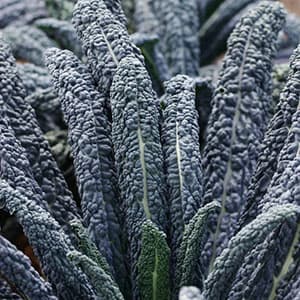
Black Magic
KaleSow directly 45cm apart from March to mid-July for summer and winter harvesting (55 days to maturity). Tasty shoots can be harvested the following spring. Min. germination rate: 80%.
Also known as lacinato or dinosaur kale - a beautiful variety with dark green, deeply ribbed leaves. Produces ample edible flower shoots in the spring after wintering.
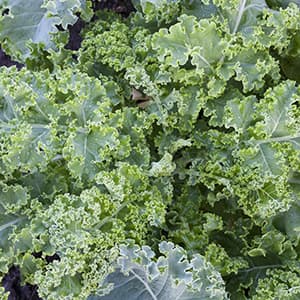
Nash’s Green
KaleSow directly 45cm apart from March to mid-July for summer and winter harvesting (55 days to maturity). Tasty shoots can be harvested the following spring. Min. germination rate: 80%.
Strong and productive with curly green leaves. Great for overwintering and has good resistance to powdery mildew. Produces ample edible flower shoots in the spring after wintering.

Scarlet
KaleSow directly 45cm apart from March to mid-July for summer and winter harvesting (55 days to maturity). Tasty shoots can be harvested the following spring. Min. germination rate: 80%.
Curly leaves ranging from purple to scarlet. A productive and cold-hardy kale.
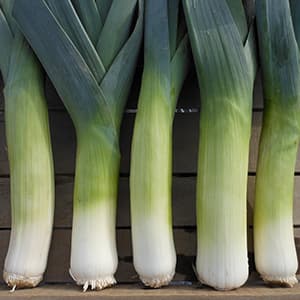
Melaton
LeekPlant in March, sowing seeds in flats indoors, 1 cm deep and 1 cm apart. Transplant 15 cm apart. Harvest in early-late fall when plants reach desired size. Min. germination rate: 65%.
Bred here at the UBC Farm and registered with the Open Source Seed Initiative. The shanks are tender with a slight sweetness, while the darker, rougher upper portions of the leeks can be cooked for soup stocks.
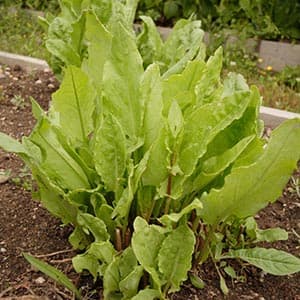
Common Sorrel
SorrelDirect sow anytime from early March until the end of summer. Cover lightly with soil, and sow 1cm apart in a block for salad greens, or 30cm for mature sorrel plants. Divide crowns every two years. Min. germination rate: 65%.
A perennial leafy green grown for its distinctive lemony flavour. Young leaves are good for eating raw, older leaves are best cooked in soups and stews.
Flowers
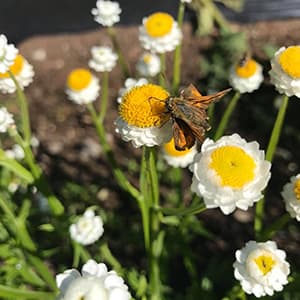
Ammobium
Winged EverlastingFor transplant (recommended), sow shallowly indoors 6 weeks before last frost, cover seeds lightly. Min. germination rate: 50%.
Small, elegant flowers with papery white petals and a yellow center. Used for dried flowers but also great for fresh-cut flowers, gets its name from the flattened stems of the flowers appearing like wings.
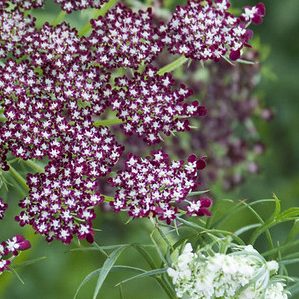
Ammi Dara
FlowerStart in trays four weeks before you intend to plant. Wait until after last frost for your first planting and harden your plants off. For better germination chill your seeds for a week before seeding. Space plants 30cm (one foot) apart.
'Dara' produces beautiful umbel type flowers, similar in appearance to Queen Anne's lace, but in an array of whites, pinks, reds and burgundies. 'Dara' is a great cut flower for mixed bouquets or as a standalone. Hang upside down to dry and have flowers in your house year round!
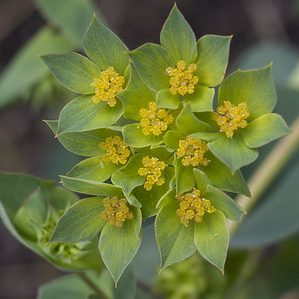
Bupleurum
Green GoldStart in trays six weeks before you intend to plant. Harden off before planting, and plan to plant after the last frost. Space plants 25cm apart.
This low growing golden flower with round, green foliage makes an excellent border plant, as well as lending beautiful colour and texture to bouquets! Stays compact and can grow well in pots also.
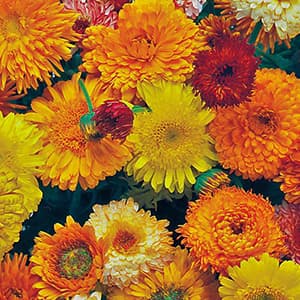
Calendula
UBC Farm MixDirect sow after the last frost. Seeds should be 6mm deep and spaced 15cm apart. Harvest flower heads once halfway open. Min. germination rate: 65%.
Bright, beautiful, and edible orange blossoms add a burst of colour to any setting--from gardens to salads. Great for pollinators. Self-seeds readily in our climate.
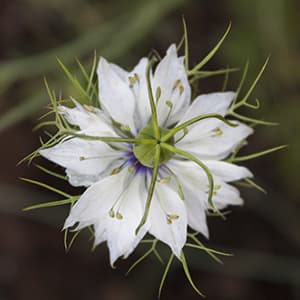
Persian Jewel
NigellaStart indoors 6 weeks before last frost or direct sow after last frost. Cover seeds lightly with soil, and aim for a final spacing of 30cm. Min. germination rate: 55%.
Beautiful delicate blue and white flowers surrounded by lacy foliage that eventually form unique seed pods perfect for fresh or dried bouquets.

Phacelia tanacetifolia
PhaceliaDirect sow anytime from last frost until mid-June. Sow 5mm deep, 10cm apart. Min. germination rate: 65%.
Also known as Purple tansy, this plant is a heavy producer of beautiful blue to purple flowers. One of the best all-around pollinator attractors. Very long bloom period and can self-seed easily in our climate.
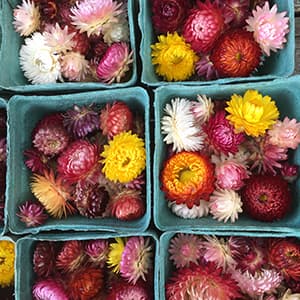
Strawflower
UBC Farm MixSow directly onto the soil surface beginning in mid-April or indoors in mid-February, spacing 30 cm apart. Min. germination rate: 60%.
Our choice mix has flowers with petals ranging from dark red to pink, white, and peach with stiff paper-like petals that are excellent for dried flower bouquets.
Herbs
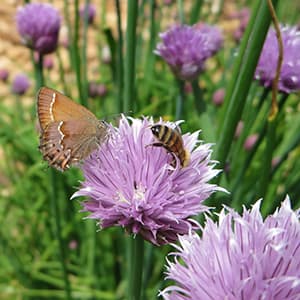
Chives
HerbBegin planting indoors February to May and transplant or sow directly in the late spring. Sow seeds 5mm deep and space 15cm apart. To harvest, cut the whole plant at ground level. Divide crowns every two years. Min. germination rate: 65%.
A versatile, hardy perennial herb with stems and flowers that can be eaten for a subtle onion flavour, cooked or fresh.
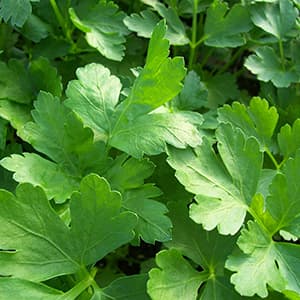
Hilmar
ParsleyFor transplant (recommended) sow seeds in 1 in containers, allowing 3 weeks for germination. For direct seeding, begin in May, sowing seeds 5mm deep with 3 seeds per 2.54 cm in a single row. Thin plants later to be 20cm apart. Min. germination rate: 55%.
Flat leafed Italian parsley for bright, flavorful garnishes. Its robust growth and cold tolerance means the same plant can be harvested again and again well into the winter months.

Bouquet
DillDirect seed after last frost. Thin seedlings to 7.6cm apart. Seed more dill every few weeks for harvest throughout the spring, summer and fall.
This flavourful classic herb is often paired with fish, potato salad and pickles. In addition to growing a nice tasting baby leaf, 'Bouquet' also grows large flowers, which are great for use as a garnish for in pickling.
Beans
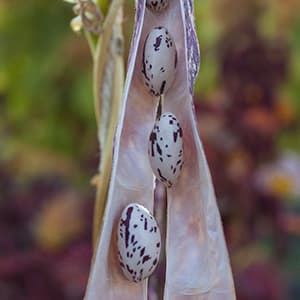
Bingo
BeanSow 2cm deep and 5 cm apart. Requires trellising to climb, and plants can climb to 2m. The pods can be harvested when deep red over a cream background, at approximately 85 days, with continuous harvest for several weeks. Min. germination rate: 80%.
A “Cranberry” or “borlotti” type pole bean known for its red and white speckled pods and beans. Bingo beans are quite productive and can be used as fresh shelling beans or allowed to dry on the plant.
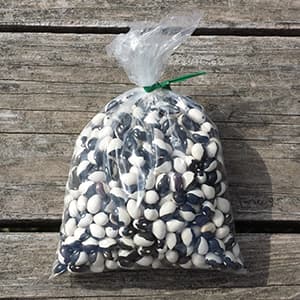
Calypso
BeanFrom the end of May to early June, directly sow beans 2 cm deep and 5cm apart with rows 60cm apart. Beans can be harvested after approximately 80 days when pods are crispy dry and beans inside are hard. Min. germination rate: 80%.
A dry bean with an iconic black and white “orca” pattern. Plants grow as compact, short bushes for easy harvest and are versatile when cooked with a delicious creamy texture--excellent for soups and stews.
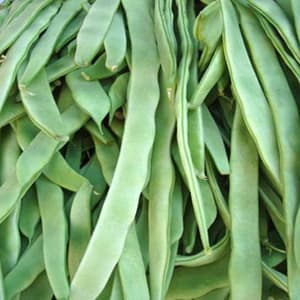
Hunter
BeanDirectly sow seeds from mid-May to mid-June, spacing seeds 30 cm apart and 3.5cm deep, providing support for them to climb. Pods are ready for harvest while 2cm wide and flat, before they get fibrous. Harvest regularly to continue the production of new pods. Min. germination rate: 80%.
A high-yielding Romano-type pole bean with flattened pods for fresh eating or cooking.
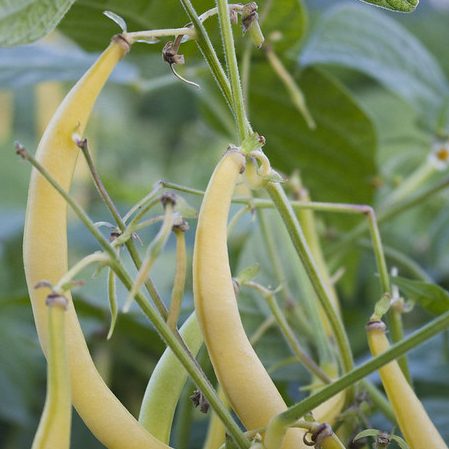
Rocdor
BeanSow seeds directly between mid-May to early-July, 5cm apart, in rows 60cm apart. Young pods are best when pencil-thin and tender. Harvest frequently to promote more bean production. Min. germination rate: 80%.
Yellow snap beans on bush plants, high yielding, early, and delicious. Great fresh or cooked.
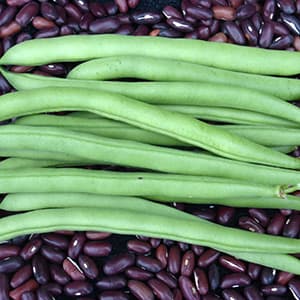
Provider
BeanSow seeds directly between mid-May to early-July, 5cm apart, in rows 60cm apart. Young pods are best when pencil-thin and tender. Harvest frequently to promote more bean production. Min. germination rate: 80%.
Green snap beans on bush plants, high yielding, early, and delicious. Great fresh or cooked.
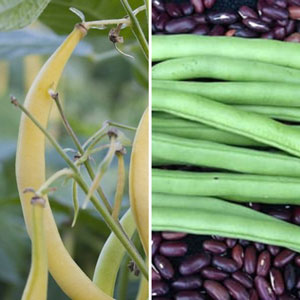
Rocdor/Provider Mix
BeanSow seeds directly between mid-May to early-July, 5cm apart, in rows 60cm apart. Young pods are best when pencil-thin and tender. Harvest frequently to promote more bean production. Min. germination rate: 80%.
A mix of green and yellow snap beans on bush plants, high yielding, early, and delicious. Great fresh or cooked.
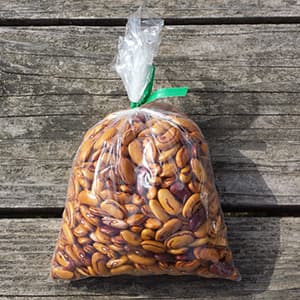
Tiger’s Eye
BeanFrom the end of May to early June, directly sow beans 2 cm deep and 5cm apart with rows 60cm apart. Beans can be harvested after approximately 80 days when pods are crispy dry and beans inside are hard. Min. germination rate: 80%.
Productive dry bush bean are ochre-coloured with burgundy stripes. Creamy in texture, rich in flavor, and are great for stews or re-fried.
Vegetables
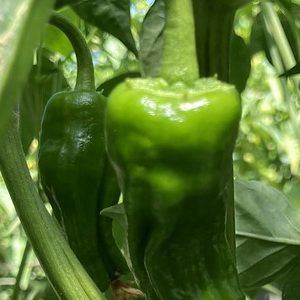
Padron
PepperStart in trays six weeks before you intend to plant. Harden off before planting, and plan to plant after the last frost. Space plants 25cm apart
A Spanish heirloom pepper, bred to be pan fried and eaten whole. Picked green, one in ten of these peppers will be spicy, turning dinner into an exciting game!
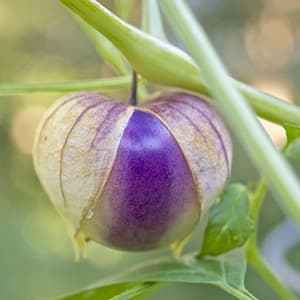
Purple Striped
TomatilloSow indoors in April-May. Transplant 60cm apart. Harvest once the husks begin to split and fruits are plump. Min. germination rate: 50%.
A cross between green and purple tomatillos, this variety is an early starter with distinct purple stripes against its dark green background. Bred here at UBC Farm and registered with the Open Source Seed Initiative. Tomatillos are the key ingredients in salsa verde.